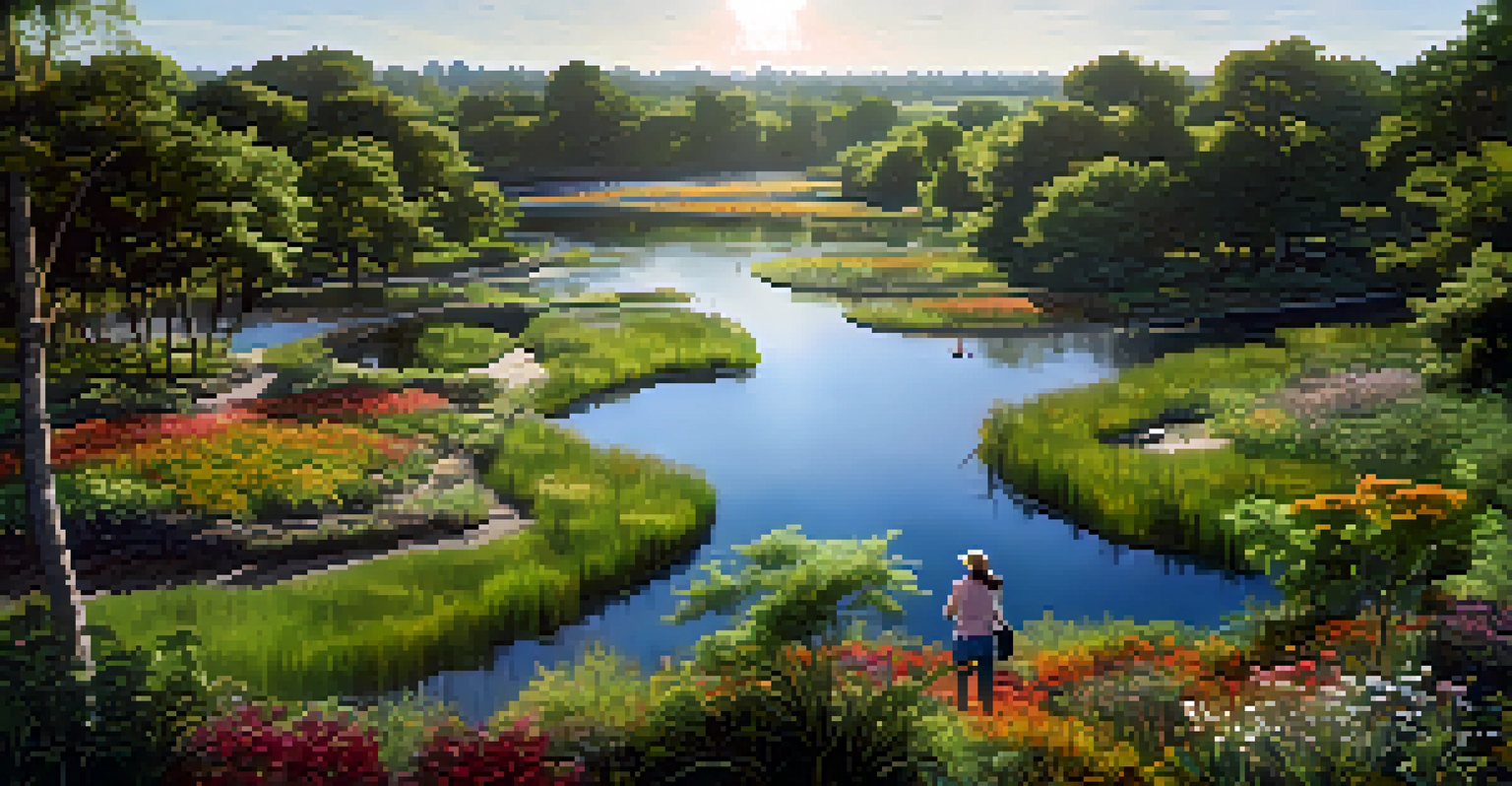Wetland Restoration in Illinois: Benefits for Climate Resilience

Understanding Wetlands: Nature's Water Buffers
Wetlands are unique ecosystems that serve as natural sponges, absorbing excess rainwater and mitigating floods. In Illinois, these areas are more than just beautiful landscapes; they play a crucial role in maintaining water quality and supporting biodiversity. By filtering pollutants and providing habitat for countless species, wetlands are vital for ecological balance.
Wetlands are among the most productive ecosystems in the world, providing vital services that benefit both nature and human society.
Think of wetlands as nature's water management system. They help regulate water levels, allowing for a more stable environment for both wildlife and human communities. When we restore these areas, we're not just preserving nature; we're investing in a healthier ecosystem that benefits everyone.
Moreover, wetlands contribute to climate resilience by sequestering carbon dioxide, which is essential in combating climate change. As we face increasing weather extremes, the role of wetlands becomes even more critical in helping us adapt and thrive.
The Climate Crisis: Why Restoration Matters
Illinois, like many regions, is grappling with the impacts of climate change, including severe storms, droughts, and unpredictable weather patterns. These changes threaten not only our environment but also our agriculture and water supply. Wetland restoration offers a proactive approach to address these challenges.

By revitalizing wetlands, we enhance their ability to absorb excess rainfall and reduce flood risks. This is particularly important in urban areas where impervious surfaces can exacerbate flooding. Restored wetlands can act as natural barriers, protecting communities from the worst effects of climate-related disasters.
Wetlands: Nature's Flood Mitigators
Wetlands absorb excess rainwater and reduce flood risks while improving water quality and biodiversity.
Additionally, healthy wetlands improve groundwater recharge, which is essential for maintaining water supplies during dry spells. This dual benefit of flood mitigation and drought resilience highlights why investing in wetland restoration is crucial for Illinois's climate strategy.
Biodiversity Benefits: A Refuge for Wildlife
Wetlands are home to diverse flora and fauna, providing habitat for countless species, some of which are threatened or endangered. In Illinois, restored wetlands can serve as critical refuges for wildlife, helping to maintain biodiversity in the face of habitat loss. This is essential not just for the animals, but for the health of the entire ecosystem.
We won’t be able to adapt to climate change without healthy wetlands and rivers to support us.
For example, migratory birds rely on wetlands as stopover points during their long journeys. By creating and restoring wetland areas, we ensure these species have the resources they need to survive and thrive. Biodiversity is important not only for ecological balance but also for the resilience of our ecosystems against climate change.
Moreover, thriving wildlife populations can contribute to healthier ecosystems, which in turn support agricultural productivity and human well-being. This interconnectedness highlights the importance of wetland restoration in maintaining a vibrant and diverse natural world.
Socioeconomic Benefits: Investing in Communities
Wetland restoration isn't just about the environment; it also brings significant socioeconomic benefits. Healthy wetlands can improve property values, enhance recreational opportunities, and attract tourism. Communities that invest in these projects often see a return on their investment through increased economic activity.
For instance, restored wetlands offer recreational activities such as birdwatching, fishing, and hiking, which can boost local economies. People are drawn to natural spaces for their beauty and the peace they provide, creating opportunities for eco-tourism and related businesses. This makes wetland restoration a win-win for both nature and local communities.
Restoration Supports Wildlife Diversity
Restored wetlands provide critical habitats for diverse species, helping to maintain ecological balance.
Furthermore, investing in green infrastructure like wetlands can reduce costs associated with stormwater management and flood damage. By taking a proactive approach to environmental challenges, communities can save money while also improving their quality of life.
Community Engagement: The Key to Successful Restoration
Successful wetland restoration projects rely heavily on community engagement and support. Local residents often possess invaluable knowledge about their environment and can play a crucial role in monitoring and maintaining restored areas. By involving the community, we ensure that these projects reflect local values and needs.
Workshops, volunteer days, and educational programs can foster a sense of ownership and pride among community members. When people understand the importance of wetlands and their role in climate resilience, they are more likely to advocate for their protection and restoration. This grassroots support can be a powerful force in driving positive change.
Moreover, collaboration between local governments, non-profit organizations, and residents can lead to more successful and sustainable restoration efforts. By working together, we can create a network of support that enhances the effectiveness and longevity of wetland restoration initiatives.
Innovative Restoration Techniques: Science in Action
As we strive to restore wetlands in Illinois, innovative techniques are being employed to maximize effectiveness. From bioengineering to natural materials, scientists are finding new ways to enhance wetland ecosystems. These methods not only support restoration but also ensure resilience against future climate challenges.
For instance, using native plant species in restoration projects helps to restore natural habitats and improve ecosystem function. Native plants are better adapted to local conditions and provide essential resources for local wildlife. They also require less maintenance, which can make restoration efforts more sustainable and cost-effective.
Community Engagement Drives Success
Involving local communities in wetland restoration fosters ownership and enhances project sustainability.
Additionally, technology plays a role in monitoring and assessing wetland health. Remote sensing and data analysis allow us to track changes over time, ensuring that restoration efforts are yielding the desired results. By combining traditional knowledge with modern science, we can create more effective and resilient wetland ecosystems.
The Future of Wetlands in Illinois: A Call to Action
The future of wetlands in Illinois hinges on our collective commitment to restoration and protection. As we face increasingly severe climate impacts, it's vital that we prioritize wetland ecosystems as part of our climate adaptation strategies. This is not just an environmental issue; it's a matter of social and economic well-being.
Everyone has a role to play in this effort, from policymakers and environmental organizations to individual citizens. Advocating for sustainable practices and supporting local restoration projects can make a significant difference. Together, we can ensure that wetlands continue to thrive and provide crucial benefits for generations to come.

Now is the time to act. By recognizing the importance of wetland restoration and committing to these initiatives, we can strengthen Illinois's resilience against climate change while fostering a healthier environment for all.